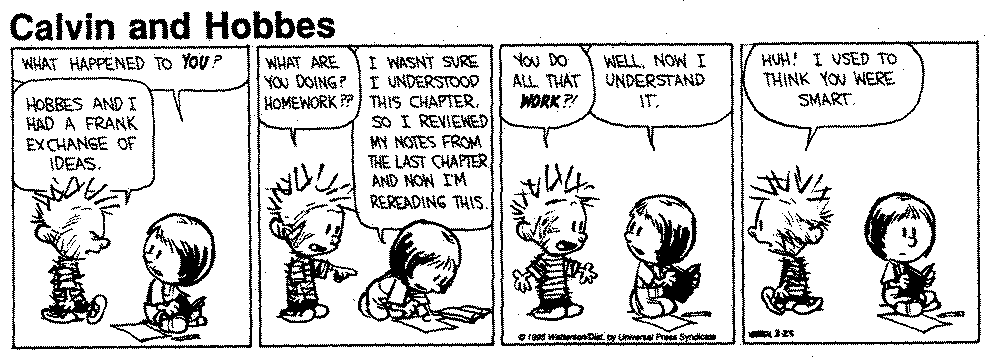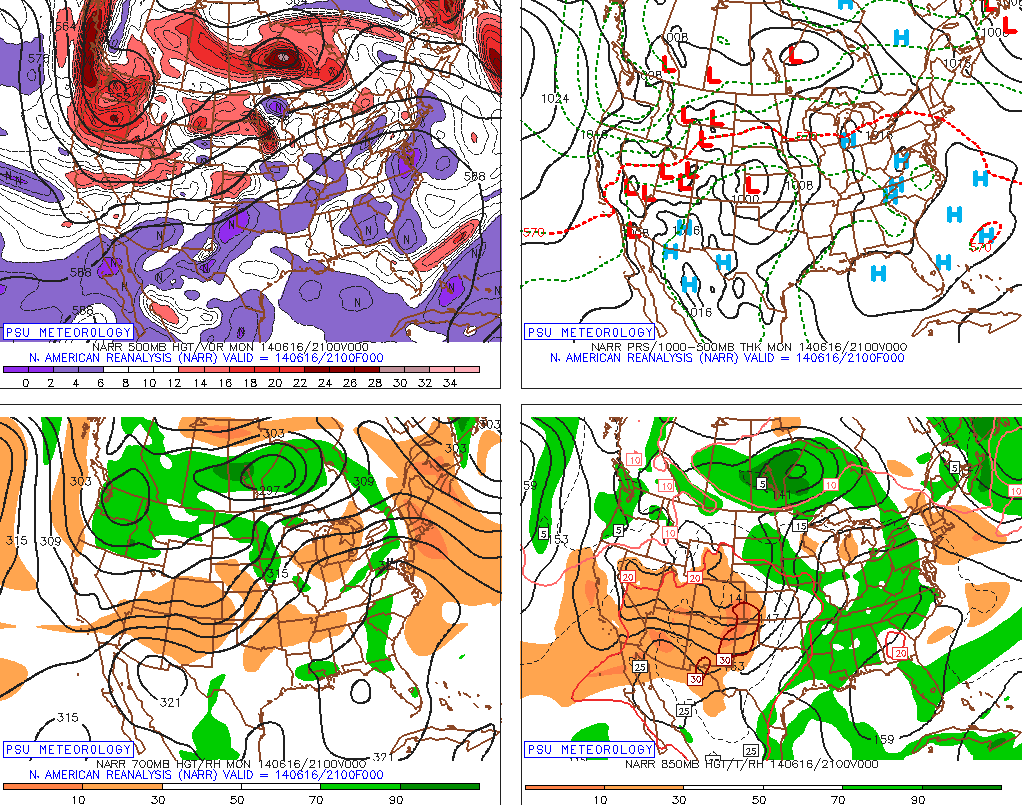My general teaching philosophy is that any good teacher should be knowledgeable and passionate about the subject he or she is teaching and also should desire that the students learn as much about the subject matter as is practical. This does not mean that students should be given twenty 50-page homework assignments in a semester-long course or be required to memorize lists of facts, derivations, and minutia for the dusty back corner of a textbook. Indeed, a lot of students placed in an overbearing environment such as this will simply disengage from the course and learn less than they would otherwise. So what is my philosophy for effectively teaching students? Read on.
General Education (100-Level) Courses
At the 100 level, I combine basic, accessible scientific concepts with vivid imagery and occasional videos to create what many students view as an educational but yet entertaining classroom experience (yes, in large lecture classes, you must be at least somewhat of an entertainer). Students do not what to be greeted with slide after slide full of text and have a professor read each slide verbatim in a monotone voice. They can probably do this more effectively themselves in their dorm rooms. To this end, I try to include at least one image on each slide to maintain student interest and to demonstrate what the phenomenon I am explaining actually is and how it works. I also usually include some text that highlights the most important points in my explanation (and to keep me on track). Since I include lots of figures and limit the amount of text, I make the slides available to the students online the day before class, so they can download them to their computers or print them off. I try to show interesting videos in class, not just someone lecturing, which I could do. For example, I show this video when I explain the vertical structure of the atmosphere; it is something that unfortunately far too many students can relate to!
I remember when I was a student during the nascent days of PowerPoint, I would race to write down everything on a slide as the professor was talking (since folks can talk faster than they can write), meaning that my concentration was on writing things down as quickly as I could and not on what the professor was actually saying. Looking back on this, I do not view this as an optimal learning environment and I thus always make my slides available to my students before class, so they know what they have to write down in class and can hopefully pay more attention to what I am actually saying. If you’re wondering about attendance, I utilize clicker points for attendance in large lecture courses and estimate that attendance averages around 75-80% in my 100-level courses. I also utilize puns and other occasional corny (as viewed by some) jokes to keep students interested; humor can be effective in teaching, but you must be careful not to overuse it.
I additionally utilize online Reading Assignments at the 100 level, most commonly as a set of multiple-choice questions to be completed prior to that day’s lecture. I’ll admit, that when I was a student in large lecture courses, I didn’t always read the assigned pages before class. I thought, “What are the chances the professor is going to call on me in a room with 300-500 people?” You don’t need to be a math or science major to know that they’re not very good! These assignments mean that students must familiarize themselves with the material before class, allowing me to teach at a slightly faster pace, cover more material, and go more in depth. One semester, I tried teaching without these assignments, and the first time I mentioned the geostrophic wind, some students looked at me like I had two heads. As a teacher, this is something I want to avoid. While I freely admit that students can look up the answers online, or get them from their friends, they are still familiarizing themselves with the material whether they like it or not. I’ve had students even admit to me that these assignments work!
Upper-Level (300- and 400-Level Courses)
I utilize much the same overall philosophy when I teach upper-level atmospheric sciences courses, except that with smaller class sizes (generally 10-40 students), I do not require the Reading Assignments or Clickers for attendance. These students are taking courses in their major; they had better be interested enough to come to class! I make sure to learn everyone’s name during their first course with me, to build a more personal connection with them. Even with the slides made available online and no attendance check, attendance in these courses averages above 90%. I am fortunate to teach many of the weather-related courses in our department, meaning that many of the students interested in the weather find the material interesting; not every slide at this level contains vivid imagery. When I perform derivations in these courses, I make sure to preface them with why were are doing them, and ask the students to think out and try to anticipate the steps in the derivations before we do them, or else ask them why we did what we did. Maintaining both a qualitative and quantitative understanding of the atmosphere is crucial to get the big picture of meteorology.
I begin both the synoptic and forecasting courses with a lengthy (15-30 minute) weather briefing so students can see firsthand how to look at the weather (you don’t start with HRRR simulated reflectivity) and how the concepts presented in class are related to the actual weather. While it would be desirable for the students to take more of a role in these briefings, I find it difficult to do this with an average enrollment between 30-40 students in these classes, especially when you consider the inherent knowledge gap between a student giving a briefing at the beginning of the semester and one doing so near the end of the term. These two courses also have a laboratory component that meets on Fridays, allowing students to examine (and isopleth!) current and forecast conditions and apply what they have learned in class to these real-world problems. In these two courses, probably only half the class time is spent lecturing.
Lecture
I believe that lecture itself has gotten a bit of a bad rap over the past few years. I believe that it has its place, especially in science and math classes where there is often only one correct answer (forecasting activities exempted, naturally). For example, given a Northern Hemisphere 500-mb height field, there exists only one correct orientation of the geostrophic wind field. This differs from many of the humanities and social sciences, in which people’s writings and historical actions can often take a myriad of interpretations, each with varying degrees of correctness. These latter scenarios obviously lend themselves better to class discussion, provided the enrollment is of the appropriate size. I often pose questions in class however, and stimulate some class discussion that way.
Exams and Memorization
Finally, when I write exams, I try to do so in such a way as to check for student understanding and learning, not just for rote memorization. While some memorization is always necessary in classes, memorization of facts and learning (i.e., knowledge retention, critical thinking, and understanding) are two vastly different things. Consider a 100-level meteorology student: If he or she wants to memorize that air flows counter-clockwise around a Northern Hemisphere low pressure system, fine. However, this same student should not memorize (as a seemingly unrelated fact written on a different index card) that it is generally colder west of a low pressure system than east of it. This instead naturally follows from the counter-clockwise circulation producing northerly winds on the west side of the low (advecting colder air from near the Poles southward) and southerly winds on the east side of the low (advecting warmer air from the Tropics northward).
Similarly, I do not require upper-level students to memorize equations or derivations for exams. For example, a student can memorize the quasi-geostrophic omega equation (including all of the factors of f and p and its derivation) until he or she is blue in the face, but unless the student is able to know physically what the terms mean and how to find them on a map (since the weather is different every day, this cannot be simply memorized), the student will learn little about weather analysis or forecasting as a result of this exercise. And let’s face it, in 21st Century America, there are few jobs that actually require students to memorize derivations, and those that do exist probably don’t pay very well and can relatively easily be replaced by machines or computers. There are some facts that require memorization, however, such as the average heights of isobaric surfaces. That said, critical thinking, quantitative reasoning, and scientific understanding is where the true power lies.




